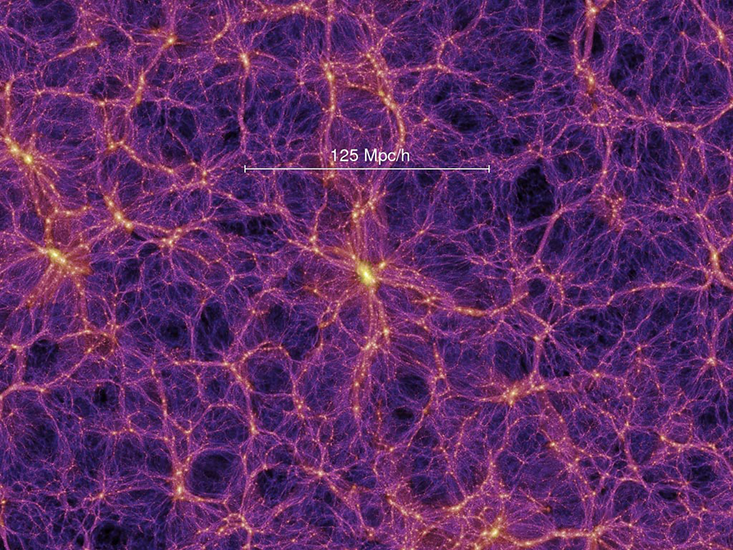The darkest hole in the universe lies near the constellation Boötes, the plowman of the northern sky. This region, called a void, is 250 million light-years across and is almost entirely bereft of matter. If you centered a region of the same size on the Milky Way, you’d find thousands of galaxies. The Boötes void has only 60. Looking in all directions from its center, the cosmos would appear dark and empty.
If galaxies are cities, then the edges of a void are the suburbs, and the center is the deepest wilderness. But an atlas isn’t complete if it includes only cities and roads; it also needs the empty spaces in between. Scientists are increasingly entering the deep, dark wilderness of the void to complete their atlas, and in doing so are learning about other, greater dark presences in our universe.
Dark matter, for example, makes up 80 percent of the matter in our universe, but neither emits nor absorbs light. Because its gravitational force gathers together atoms to make galaxies and clusters of galaxies, though, the stars, gas, and dust that constitute the visible stuff of the cosmos reflect the underlying dark matter distribution. Where galaxies are thickest, dark matter is densest. The reverse is also true: In a region empty (or nearly so) of galaxies, dark matter should be sparse.
“Voids are vast, shallow troughs in the dark matter [distribution],” explains Joseph Clampitt, a post-doctoral researcher at the University of Pennsylvania. “Galaxies sit at the center of narrow, towering peaks.” If you use height as a stand-in for density, “a typical galaxy has the same height and footprint as the Empire State Building [and] a medium-size void would be a 3-foot-deep hole three times the size of Manhattan.” Find the voids, fill out your dark matter map.
Only by measuring that third dimension can we grasp how incredibly huge and empty these regions are.
Voids can also tell scientists about another darkness, called dark energy. It drives the acceleration of the expansion of the universe, and therefore the size and number of voids. Peter Melchior, a cosmologist at the Center for Cosmology and Astro-Particle Physics at Ohio State University, says that a measurement of the distribution of void sizes and profile shapes would help pin down this mysterious force. “It would give us information about how strongly dark energy works, because [dark energy] would affect the growth of [void] size over time.”
As empty as they are, then, voids are full of promise. The only problem is, how can you find an emptiness in the vast fullness of space?

Even the enormous Boötes void evaded detection until 1981, when it was discovered by Robert Kirshner and colleagues. While we inhabit a three-dimensional universe, our view of the sky is two-dimensional because the vastness of the cosmos stymies our depth perception. A void is both large and mostly empty, but galaxies in both the foreground and background obscure it from our view. Only by measuring that third dimension with precision instruments can we grasp how incredibly huge and empty these regions are.
Since the discovery of the Boötes void, astronomers have found a number of similar empty patches using similar methods. There’s even one near the Milky Way, creatively named the Local Void. Voids are ubiquitous, and come in a range of sizes and shapes. But it’s not enough to know voids exist: Scientists want to know how many there are, how large they are, and how they are distributed in space and time.
To accomplish this, scientists are turning to gravity. All forms of matter and energy exert a gravitational force, which in turn affects the path of light, as predicted by Einstein’s general theory of relativity. “The gravitational deflection of light by mass is similar to the familiar effects of a glass lens or prism,” says Clampitt—although it is much harder to observe. Where matter is dense, light is affected strongly, producing striking multiple distorted images of distant objects; that effect is known as strong gravitational lensing. Where matter is rarified, the result is a “weak lensing” that is more subtle: twisting light, magnifying background galaxies slightly, and other small tweaks that require careful observation to detect.
These different lensing behaviors can be used to find voids. As Clampitt explains, a galaxy or galaxy cluster will produce a gravitational lensing signature “that is tangential or barrel-shaped,” while voids “imprint a radial or pincushion pattern.” Although individual voids produce too weak a gravitational signature to detect reliably, Melchior and his collaborators proved this year that the gravitational signature of many voids together can be detected. They took 901 known cosmic voids from the vast Sloan Digital Sky Survey (SDSS) and “stacked” them, averaging the light passing through them to extract their general gravitational properties. Starting from voids that were already identified, the team compared the voids’ lensing signals to what is expected from theoretical models, to see if the voids were truly as empty as expected. They were—so patches of the cosmos with very few galaxies also have very little dark matter. That’s an expected but pleasant confirmation of cosmological theory.

At the University of Pennsylvania, Clampitt took a complementary approach that was not restricted to voids that had already been identified. With University of Pennsylvania astrophysicist Bhuvnesh Jain, he directly searched the SDSS catalog for the weak gravitational lensing signature expected from voids, without first relying on galaxy distributions. This turned up around 20,000 possible voids, which the researchers now plan to check against galaxy distribution data.
The use of gravitational lensing to find voids is novel, says Asantha Cooray, a cosmologist at the University of California, Irvine. “Before these two papers weak lensing has been mainly used to measure mass concentrations like galaxy clusters and groups. The measurements provide lensing-based estimates of the void size… [and] confirm there are indeed large regions in the universe that are devoid of galaxies,” he explains. Additionally, these papers confirm a major aspect of the theory of galaxy formation: Dark matter forms knots and filaments, with large empty spaces in between.
The center of the Boötes void is relatively close by: about 700 million light-years away from Earth. However, many voids are much farther away than that, scattered across the sky. SDSS and its successor the Baryon Oscillation Spectroscopic Survey (BOSS), which are based at the Apache Point Observatory in New Mexico, cover one patch of the northern hemisphere sky, chosen largely to look away from the thickest part of the Milky Way. Other surveys, including several currently in the planning stage, will cover more of the sky, specifically looking at weak gravitational lensing and void lensing.
Voids, then, will be an important part of the future of astronomy—and, for that matter, of the universe itself. That’s because, in the far future, the cosmos will be more void than not, thanks to the actions of dark energy. The cosmic web will shred, leaving only wisps in the deep darkness of intergalactic space. Trillions of years in the future, matter, not voids, will be the exception.
Matthew R. Francis is a physicist, science writer, public speaker, and educator.






























